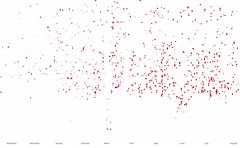I can't remember the last time I drove past the Gap in my town and they did not have a big SALE sign in the window. Sometimes it is just a one day sale, or a sale on top of another sale. As a result, I can't believe that people actually pay full price for anything at the Gap. Why would they when they know if they wait a few days the item will most likely be discounted. The constant sales promotions have damaged the brand in my mind as I do not believe the clothes are worth full price. The Gap used to be one of the top brands in the country but, to me, it is now is relegated to third tier status.
The Gap reached an adjusted high of about $55 per share in 2000, but has been bouncing along in the high 20's or low 30's since around 2002. It would be interesting to know when they started their aggressive discounting policy. My guess is that it began when the stock began to fall and competition increased.
Discounting is common in all industries, particularly the software vertical where customers expect a discount and will wait until a quarters end to get the best possible price. I worked at The Mathworks a few years ago and they are the only firm that I know of that refuses to discount and actually gets away with it. Customers now know the discount policy and do not ask for one. The Mathworks has been a very fast growing company in a competitive space so it is interesting that they continue to be able to get away without discounting. I believe they have done a great job of linking price to value and have enhanced their brand in the eyes of their customers. They are a model that others should try to replicate.
Recently, a competitor of ours at Harvard Business Publishing has been offering a 25% discount on their courses through year end. The competitor is a high end, well know brand in the corporate learning space so it was a big surprise that they were doing so. Their policy is a great competitive selling point for us as we can plant the seed of doubt in our prospects minds that their courses must be inferior to ours if they have to run a sale.
Once you start to discount your product or service it is very hard to get full price or even raise prices.Price should equal value but if a customer knows you will eventually cave in and discount than you have lost that relationship and your brand suffers in the end.
Thursday, December 31, 2009
Tuesday, December 29, 2009
How do you break through the noise of Twitter?
The constant stream of tweets makes it almost impossible to connect with your followers unless they are constantly online monitoring you. There are certainly people out there that seem to be consistently updating and informing their followers but that seems to be the exception rather than the rule. Additionally, these users are ones that are tweeting to try and promote their own brand or company. Twitter almost seems like one big advertising feed to me.
Yes, I know there are tools that can help you track and find certain topics, but these seem more geared toward the marketer trying to analyze their own data rather than an end user seeking out specific information. The constant flow of tweets makes it difficult to leverage your Twitter network for inbound marketing purposes. I have had some success with inbound marketing when I have offered free white papers or articles, but not everyone has access to the Harvard Business Publishing library like I do.
I would be interested in hearing how others have succeeded or failed in trying to break through the constant noise of tweets to generate tangible business results.
Yes, I know there are tools that can help you track and find certain topics, but these seem more geared toward the marketer trying to analyze their own data rather than an end user seeking out specific information. The constant flow of tweets makes it difficult to leverage your Twitter network for inbound marketing purposes. I have had some success with inbound marketing when I have offered free white papers or articles, but not everyone has access to the Harvard Business Publishing library like I do.
I would be interested in hearing how others have succeeded or failed in trying to break through the constant noise of tweets to generate tangible business results.
Subscribe to:
Posts (Atom)


![Reblog this post [with Zemanta]](http://img.zemanta.com/reblog_e.png?x-id=dd7c15be-a3ee-4376-a5f8-0aafb99e534c)